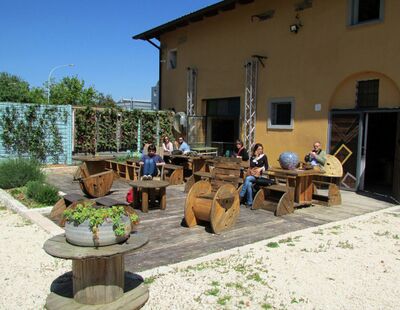LED2LEAP 2020 - Bologna Team 2
>>>back to working groups overview
Landscape Democracy Rationale
- Why do you think this community context is relevant from a landscape democracy perspective? What is your hypothesis considering the landscape democracy challenges?
- Format: 3-4 sentences
Location and scope
Phase A: Mapping your Community
Places
There are two locations, one in the Villaggio del Fanciullo, in Scipione del Ferro street, near the railway station the other is called Spazio Battirame. The Villaggio del Fanciullo is called in this way because different social realities live there, a kind of smart village built in the 20s that from a convent has become a place where different social realities and other cooperatives meet. In this once-religious space different legal entities share the location and have a common background. There was an initial division between the people that were sent to share a space and had apparently nothing in common. But through out time, a symbiotic mechanism is activated, allowing the actors to cooperate and live together in the shared space. Instead Spazio Battirame initially was a colonic house from the nineteenth century, owned (ound) by one of the most important family in Bologna at the time. A strip of land is still connected to this space, revealing the Roman geometric scanning of the fields still present today. This colonic house still has a stable and a barn; in the 70s it was abandoned and lost its historic value. In the 90s a social center was moved in the area; more over, a tensile structure, initially built for Italia 90 Worldcup was reused there and divided into two parts. The association that stayed there, Livello 57, usually was a source of public disorder, organizing concerts and various events. At the end of 2007 there was a gas explosion causing victims; and for this reason everything was closed. The place, left to itself, became a place of abusive activities, until the arrival of Eta Beta In 2014; their presence lead to the transformation of this land from the industrial area of Bologna into an agricultural area, with teaching rooms and a restaurant that opened soon after their presence began to be noticed.
Socio-economic characteristics
The cooperative is a mixed type cooperative, being at the same time type A and type B. These cooperatives in general have a difference in their balance sheets and financial reports and in how they are viewed by the central government. The type B cooperative mainly deals with production work with disadvantaged groups that can be various, but in particular it deals with the sector of psychiatry, addictions and social problems.
The community is thought as an enclosed circle that three pillars sustain:
- The man, intended both as citizen and as monk, in the greek meaning of the word, “monakos”, that stands for a lonely part in his relationship to the others;
- Wellness and community, as individual well-being, and as collective community health;
- Creativity, because the well-being in a community is made possible by making unique things with benefits on the community itself.
Groups of actors and stakeholders in your community
The cooperative works with the following disadvantaged groups:
- people with addictions;
- people with psychiatric needs;
- unaccompained minor;
- Prisoners;
- Foreigners;
- Refugees.
- Yourcase actorgroups1.jpg
add a caption
- Yourcase actorgroups2.jpg
add a caption
Relationships between your actors and groups
- How would you describe the power relationship between the groups?
- Which groups may have shared interests and which are these? (max 200 signs)
- add 1-2 graphical representations to the image gallery based on your PPT presentation, you can add more if you like
- Your actor relationships 1.jpg
add a caption
- Your actor relationships 2.jpg
add a caption
Summary of your learnings from the transnational discussion panel on April 22
On April 22 you will present the PPT version of this first assignment to other seminar groups working in other geographical community contexts. Please give here a short summary of your learnings during this presentation, for example:
- Other analytical approaches
- Other representation styles
- Other value schemes: any surprises?
- Constructive comments we received on our presentation
Theory reflection
- Reflect on at least three readings from the first section 'Democratic Landscape Transformation
- You can choose references from our reading list or suggest others
- Scope: 250 words
References
- give a full list of the references you have used for this section
Phase B: Democratic Landscape Analysis and Assessment
* template coming
Phase C: Collaborative Visioning and Goal Setting
* template coming
Phase D: Collaborative Design, Transformation and Planning
* template coming
Phase E: Collaborative Design, Transformation and Planning
* template coming
= Phase E: Collaborative Evaluation and Future Agendas * template coming
Process Reflection
- Reflect in your intercultural and interdisciplinary team on the outcomes of your study
- Which limitations were you facing?
- What have you learnt from each other?
- What would you do differently next time?
- You can also use diagrams/visuals
- 250 words text


